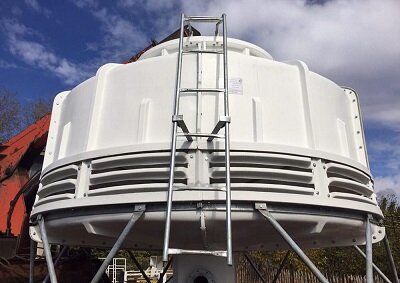Everything about DamaTajhiz Cooling Tower

Cooling tower is a device used to dissipate the heat and create a cooling action in factories, refineries, water chillers of the air conditioning systems of large buildings and various industries. In fact, a cooling tower is a type of heat exchanger which dissipates water heat and lowers its temperature by bringing air and water into direct contact.
In the air conditioning process, 3 factors of temperature, humidity and air flow must be controlled. Accordingly, all air conditioners use a fluid to transfer heat, which can be "all air", "all water" or "air-water", depending on the type of equipment.
Dama Tajhiz has been operating in the field of air conditioning systems and cooling and heating equipment for many years, and the cooling tower is one of its products. Thanks to its technical knowledge and high experience, its cooling towers are produced with very high quality and exported to West Asian countries. The application, advantages and various types of this device are explained below.

Application
In most factories and industrial processes, heat dissipation is an important issue for continuing operation. To this aim, water is usually used to remove the excess heat from the system. In the past, natural water such as river water was used for this purpose. In this way, the river water passed through the system, absorbed the excess heat and then returned to the river bed or was discharged into the sewage.
The cost of water supply increased dramatically over time, and given ecological problems, the environmental protection laws became much stricter. Given these conditions, the use of natural water resources was not feasible and even economical anymore; therefore, cooling systems such as cooling towers were designed to dissipate excess heat from industrial units and residential buildings.
Function
The figure below shows the inlet, outlet and main part of a cooling tower.
The feed water, which may come from a well, municipal water or any other source, enters a cooling tower through the inlet pipe, as shown in the middle of the image on the left, and after the refrigeration process, water with the desired temperature flows out of the outlet line, as shown at the bottom right side of the image.
But what happens in a cooling tower and how does it reduce the inlet water temperature?
Inlet water temperature reduction is based on thermal exchange between water and air. We know that water needs a lot of heat to evaporate, and the cooling tower operates on this basis.
A very small amount of water evaporates due to more heat reception, and this heat and water vapor is discharged from the cooling tower by a fan. As a result, the water that remains in the tank of the device will have a lower temperature because of its losing the excess heat.
How does this happen operationally?
The tank water is pumped to the nozzles located at the top of the cooling tower. The pumped water is then spilt by the nozzles in droplet sizes into the packings between the nozzle and the cooling tower tank.
Meanwhile, the air inside the cooling tower, which has more heat, moves upwards and collides with the water droplets on the packings, causing a small portion of the droplets to evaporate. With this superficial evaporation that occurs in water droplets, what remains from these droplets loses most of its heat, cools down and returns to the device tank with a lower temperature.
Now that we have understood the general water cooling process in a cooling tower, the following two more questions spring to mind:
1- What is a cooling tower packing and what is its function?
2- How does hot air flow from the bottom upwards to discharge excess heat and water vapor?
To answer the first question, we must say that according to the laws of physics, the higher the air-water contact level, the more superficial evaporation and consequently the more heat transfer. Therefore, cooling towers should be designed in such a way that they enable a higher level of water-to-air contact. A packing is used for this purpose.
In the past, wood, straw and clay were used in cooling towers for this purpose, but the packings' material changed over time thanks to technological advances.
Nowadays, Dama Tajhiz utilizes honeycomb or PVC packings to increase the efficiency and cooling capacity of cooling towers.
Another important factor in increasing the efficiency of packings is their dimensions, which have a direct effect on the amount of joint surface and the duration of water-to-air contact. Because of the limited space inside the packings, the optimal size for cooling surfaces should be considered in the construction of cooling towers.
Price of Dama Tajhiz cooling towers
When purchasing the device, you should pay more attention to its quality, thickness of its fiberglass body and its required capacity than its price. After choosing the right size for your desired application, you should know that the quality and price of the device are affected by various parameters, including:
- Material: fiberglass, metal or concrete
- Capacity
- Body thickness and quality of raw materials used in the body
- Shape (being round or cubic)
- Whether the cooling system circuit is open or closed
In addition to producing cooling towers with the best and most quality materials, Dama Tajhiz has provided the possibility of its purchase for Iran's neighboring countries such as Iraq, UAE, Turkey, Qatar and other West Asian countries at reasonable prices.
Leave a Comment